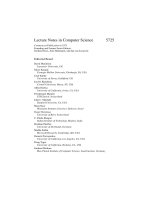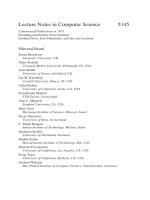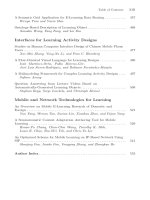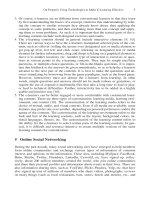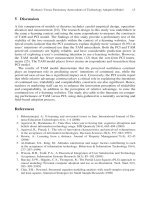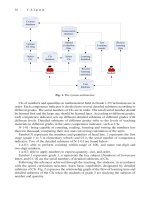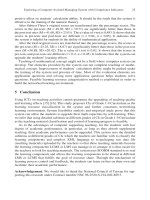Lecture Notes in Computer Science Edited pptx
Bạn đang xem bản rút gọn của tài liệu. Xem và tải ngay bản đầy đủ của tài liệu tại đây (17.48 MB, 203 trang )
Lecture Notes in Computer Science
Edited by G. Goos, J. Hartmanis and J. van Leeuwen
1016
Advisory Board: W. Brauer D. Gries J. Stoer
Roberto Cipolla
Active Visual Inference
of Surface Shape
Springer
Series Editors
Gerhard Goos
Universit~it Karlsruhe
Vincenz-Priessnitz-StraBe 3, D-76128 Karlsruhe, Germany
Juris Hartmanis
Department of Computer Science, Cornell University
4130 Upson Hall, Ithaca, NY 14853, USA
Jan van Leeuwen
Department of Computer Science,Utrecht University
Padualaan 14, 3584 CH Utrecht, The Netherlands
Author
Roberto Cipolla
Department of Engineering, University of Cambridge
Trumpington Street, CB2 1PZ Cambridge, UK
Cataloging-in-Publication data applied for
Die Deutsche Bibliothek - CIP-Einheitsaufnahme
Cipolla, Roberto:
Active visual inference of surface shape / Roberto Cipolla. -
Berlin ; Heidelberg ; New York ; Barcelona ; Budapest ; Hong
Kong ; London ; Milan ; Paris ; Santa Clara ; Singapore ;
Tokyo : Springer, 1995
(Lecture notes in computer science ; 1016)
ISBN 3-540-60642-4
NE: GT
CR Subject Classification (1991): 1.4, 1.2.9, 1.3.5, 1.5.4
Cover Illustration: Newton after William Blake
by Sir Eduardo Paolozzi (1992)
ISBN 3-540-60642-4 Springer-Verlag Berlin Heidelberg New York
This work is subject to copyright. All rights are reserved, whether the whole or part of the material is
concerned, specifically the rights of translation, reprinting, re-use of illustrations, recitation, broadcasting,
reproduction on microfilms or in any other way, and storage in data banks. Duplication of this publication
or parts thereof is permitted only under the provisions of the German Copyright Law of September 9, 1965,
in its current version, and permission for use must always be obtained from Springer-Verlag. Violations are
liable for prosecution under the German Copyright Law.
9 Springer-Verlag Berlin Heidelberg 1996
Printed in Germany
Typesetting: Camera-ready by author
SPIN 10486004 06/3142 - 5 4 3 2 1 0 Printed on acid-free paper
Every one says something true about the nature of things, and while individually
they contribute little or nothing to the truth, by the union of all a considerable
amount is amassed.
Aristotle, Metaphysics Book 2
The Complete Works of Aristotle,
Princeton University Press, 1984.
Preface
Robots manipulating and navigating in unmodelled environments need robust
geometric cues to recover scene structure. Vision can provide some of the most
powerful cues. However, describing and inferring geometric information about
arbitrarily curved surfaces from visual cues is a difficult problem in computer
vision. Existing methods of recovering the three-dimensional shape of visible sur-
faces, e.g.
stereo
and
structure from motion,
are inadequate in their treatment
of curved surfaces, especially when surface texture is sparse. They also lack ro-
bustness in the presence of measurement noise or when their design assumptions
are violated. This book addresses these limitations and shortcomings.
Firstly novel computational theories relating visual motion arising from viewer
movements to the
differential geometry
of visible surfaces are presented. It is
shown how an
active
monocular observer, making deliberate exploratory move-
ments, can recover reliable descriptions of curved surfaces by tracking image
curves. The deformation of
apparent contours
(outlines of curved surfaces) un-
der viewer motion is analysed and it is shown how surface curvature can be
inferred from the
acceleration
of image features. The image motion of other
curves on surfaces is then considered, concentrating on aspects of surface geom-
etry which can be recovered efficiently and robustly and which are insensitive to
the exact details of viewer motion. Examples include the recovery of the sign
of
normal curvature
from the image motion of inflections and the recovery of
surface orientation and
time to contact
from the
differential invariants
of the
image velocity field computed at image curves.
These theories have been implemented and tested using a real-time tracking
system based on deformable contours (B-spline snakes). Examples are presented
in which the visually derived geometry of piecewise smooth surfaces is used in a
variety of tasks including the geometric modelling of objects, obstacle avoidance
and navigation and object manipulation.
VIII Preface
Acknowledgements
The work described in this book was carried out at the Department of Engineer-
ing Science of the University of Oxford 'under the supervision of Andrew Blake.
I am extremely grateful to him for his astute and incisive guidance and the cat-
alyst for many of the ideas described here. Co-authored extracts from Chapter
2, 3 and 5 have been been published in the International Journal of Computer
Vision, International Journal of Robotics Research, Image and Vision Comput-
ing, and in the proceedings of the International and European Conferences on
Computer Vision. I am also grateful to Andrew Zisserman for his diligent proof
reading, technical advice, and enthusiastic encouragement. A co-authored ar-
ticle extracted from part of Chapter 4 appears in the International Journal of
Computer Vision.
I have benefited considerably from discussions with members of the Robotics
Research Group and members of the international vision research community.
These include Olivier Faugeras, Peter Giblin, Kenichi Kanatani, Jan Koen-
derink, Christopher Longuet-Higgins, Steve Maybank, and Joseph Mundy.
Lastly I am indebted to Professor J.M. Brady, for providing financial support,
excellent research facilities, direction, and leadership. This research was funded
by the IBM UK Science Centre and the Lady Wolfson Junior Research Fellowship
at St Hugh's College, Oxford.
Dedication
This book is dedicated to my parents, Concetta and Salvatore Cipolla. Their
loving support and attention, and their encouragement to stay in higher educa-
tion (despite the sacrifices that this entailed for them) gave me the strength to
persevere.
Cambridge, August 1992 Roberto Cipolla
Contents
Introduction
1.1 Motivation
1
1.1.1 Depth cues from stereo and structure from motion 1
1.1.2 Shortcomings 5
1.2 Approach 7
1.2.1 Visual motion and differential geometry 7
1.2.2 Active vision 7
1.2.3 Shape representation 8
1.2.4 Task oriented vision 9
1.3 Themes and contributions 9
1.3.1 Curved surfaces 9
1.3.2 Robustness 10
1.4 Outline of book 11
Surface Shape from the Deformation of Apparent Contours 13
2.1 Introduction 13
2.2 Theoretical framework 15
2.2.1 The apparent contour and its contour generator 15
2.2.2 Surface geometry 17
2.2.3 Imaging model 20
2.2.4 Viewer and reference co-ord~nate systems 21
2.3 Geometric properties of the contour generator and its projection 21
2.3.1 Tangency 22
2.3.2 Conjugate direction relationship of ray and contour generator 22
2.4 Static properties of apparent contours 23
2.4.1 Surface normal 26
2.4.2 Sign of normal curvature along the contour generator . . 26
2.4.3 Sign of Gaussian curvature 28
2.5 The dynamic analysis of apparent contours 29
2.5.1 Spatio-temporal parameterisation 29
• Contents
2.5.2 Epipolar parameterisation 30
2.6 Dynamic properties of apparent contours 33
2.6.1 Recovery of depth from image velocities 33
2.6.2 Surface curvature from deformation of the apparent contour 33
2.6.3 Sidedness of apparent contour and contour generator . . . 35
2.6.4 Gaussian and mean curvature 36
2.6.5 Degenerate cases of the epipolar parameterisation 36
2.7 Motion parallax and the robust estimation of surface curvature . 37
2.7.1 Motion parallax 41
2.7.2 Rate of parallax 42
2.7.3 Degradation of sensitivity with separation of points 44
2.7.4 Qualitative shape 45
2.8 Summary 45
Deformation of Apparent Contours - Implementation
3.1
3.2
47
Introduction 47
Tracking image contours with B-spline snakes 48
3.2.1 Active contours - snakes 50
3.2.2 The B-spline snake 51
3.3 The epipolar parameterisation'. 57
3.3.1 Epipolar plane image analysis 58
3,3.2 Discrete viewpoint analysis 64
3.4 Error and sensitivity analysis 68
3.5 Detecting extremal boundaries and recovering surface shape . . . 71
3.5.1 Discriminating between fixed and extremal boundaries . . 7]
3.5.2 Reconstruction of surfaces 75
3.6 Real-time experiments exploiting visually derived shape information 78
3.6.1 Visual navigation around curved objects 78
3.6.2 Manipulation of curved objects 79
Qualitative Shape
from Images of Surface Curves
4.1
4.2
4.3
81
Introduction 81
The perspective projection of space curves 84
4.2.1 Review of space curve geometry 84
4.2.2 Spherical camera notation 86
4.2.3 Relating image and space curve geometry 88
Deformation due to viewer movements 90
4.3.1 Depth fl'om image velocities 92
4.3.2 Curve tangent from rate of change of orientation of image
tangent ' 93
4.3.3 Curvature and curve normal 94
Contents
Xl
6
A
4.4 Surface geometry 95
4.4.1 Visibility constraint 95
4.4.2 Tangency constraint 97
4.4.3 Sign of normal curvature at inflections 97
4.4.4 Surface curvature at curve intersections 107
4.5 Ego-motion from the image motion of curves 109
4.6 Summary 114
Orientation and
Time to Contact from Image Divergence
and
Deformation
117
5.1 Introduction 117
5.2 Structure from motion 118
5.2.1 Background 118
5.2.2 Problems with this approach 119
5.2.3 The advantages of partial solutions 120
5.3 Differential invariants of the image velocity field 121
5.3.1 Review 121
5.3.2 Relation to 3D shape and viewer ego-motion 125
5.3.3 Applications 131
5.3.4 Extraction of differential invariants 133
5.4 Recovery of differential invariants from closed contours 136
5.5 Implementation and experimental results 139
5.5.1 Tracking closed loop contours 139
5.5.2 Recovery of time to contact and surface orientation 140
Conclusions
151
6.1 Summary 151
6.2 Future work 152
Bibliographical Notes
A.1
A.2
A.3
A.4
A.5
155
Stereo vision 155
Surface reconstruction 157
Structure from motion 159
Measurement and analysis of visual motion 160
A.4.1
A.4.2
A.4.3
A.4.4
A.4.5
A.4.6
Monocular shape cues
Difference techniques 160
Spatio-temporal gradient techniques 160
Token matching 161
Kalman filtering 164
Detection of independent motion 164
Visual attention 165
166
Xll Contents
A.6
A.5.1 Shape from shading 166
A.5.2 Interpreting line drawings 167
A.5.3 Shape from contour 168
A.5.4 Shape from texture 169
Curved surfaces 169
A.6.1 Aspect graph and singularity theory 169
A.6.2 Shape from specularities 170
B Orthographic projection and planar motion
172
C Determining
5tt.n
from the spatio-temporal image
q(s,t)
175
D Correction for parallax based measurements when image points
are not coincident 177
Bibliography 179
Chapter 1
Introduction
1.1 Motivation
Robots manipulating and navigating in unmodelled environments need robust
geometric cues to recover scene structure.
Vision -
the process of discovering
fl'om images what is present in the world and where it is [144] - can provide
some of the most powerful cues.
Vision is an extremely complicated sense. Understanding how our visual
systems recognise familiar objects in a scene as well as describing qualitatively
the position, orientation and three-dimensional (3D) shape of unfamiliar ones,
has been the subject of intense curiosity and investigation in subjects as disparate
as philosophy, psychology, psychophysics, physiology and artificial intelligence
(AI) for many years. The AI approach is exemplified by computational theories
of vision [144]. These analyse vision as a complex information processing task
and use the precise language and methods of computation to describe, debate
and test models of visual processing. Their aim is to elucidate the information
present in visual sensory data and how it should be processed to recover reliable
three-dimensional descriptions of visible surfaces.
1.1.1 Depth cues from stereo and structure from motion
Although visual images contain cues to surface shape and depth, e.g. perspective
cues such as vanishing points and texture gradients [86], their interpretation
is inherently ambiguous. This is attested by the fact that the human visual
system is deceived by "trompe d'oeuil" used by artists and visual illusions, e.g.
the Ames room [110, 89], when shown a single image or viewing a scene from
a single viewpoint. The ambiguity in interpretation arises because information
is lost in the projection from the three~dimensional world to two-dimensional
images.
Multiple images from different viewpoints can resolve these ambiguities. Vis-
ible surfaces which yield almost no depth perception cues when viewed from a
single viewpoint, or when stationary, yield vivid 3D impressions when movement
2 Chap. 1. Introduction
(either of the viewer or object) is introduced. These effects are known as
stereop-
sis
(viewing the scene from different viewpoints simultaneously as in binocular
vision [146]) and
kineopsis (
the "kinetic depth" effect due to relative motion
between the viewer and the scene [86, 206]). In computer vision the respective
paradigms are
stereo vision
[14] and
structure from motion
[201].
In stereo vision the processing involved can be decomposed into two parts.
1. The extraction of disparities (difference in image positions). This involves
matching image features that correspond to the projection of the same
scene point. This is referred to as the
correspondence problem.
It concerns
which features should be matched and the constraints that can be used to
help match them [147, 10, 152, 171, 8].
.
The interpretation of disparities as 3D depths of the scene point. This
requires knowledge of the camera/eye geometry and the relative positions
and orientations of the viewpoints
(epipolar geometry
[10]). This is essen-
tially triangulation of two visual rays (determined by image measurements
and camera orientations) and a known baseline (defined by the relative
positions of the two viewpoints). Their intersection in space determines
the position of the scene point.
Structure fl'om motion can be considered in a similar way to stereo but with
the different viewpoints resulting from (unknown) relative motion of the viewer
and the scene. The emphasis of structure from motion approach has been to
determine thc number of (image) points and the number of views needed to
recover the spatial configuration of thc scene points and the motion compatible
with the views [201,135]. The processing involved can be decomposed into three
parts.
1.
.
Tracking fi.'atures (usually 2D image structures such as points or "cor-
nel's ~ ) 9
Interpreting their image motion as arising from a
rigid
motion in 3D. This
can be used to estimate the exact details (translation and rotation) of the
relative motion.
.
Image velocities and viewer motion can then be interpreted in the same
way as stereo disparities and epipolar geometry (see above). These are used
to recover the scene structure which is expressed explicitly as quantitative
depths (up to a speed-scMe ambiguity).
The computational nature of these problems has been the focus of a signif-
icant amount of research during the past two decades. Many aspects are well
1.1. Motivation 3
Figure 1.1: Stereo image pair with polyhedral model.
The Sheffield Tina stereo algorithm
[171]
uses Canny edge detection
[48]
and
accurate camera calibration
[195]
to extract and match 21) edges in the left (a)
and right (b) images of a stereo pair. The reconstructed 3D line segments are
interpreted as the edges of a polyhedral object and used to match the object to a
model database
[179].
The models are shown superimposed on the original image
(a). Courtesy of I. Reid, University of Oxford.
4 Chap. 1. Introduction
Figure 1.2: Structure from motion.
(a) Detected image "corners"
[97, 208]
in the first frame of an image sequence.
Thc motion of the corners is used to estimate the camera's motion (ego-motion)
[93].
The integration of image measurements from a large number of viewpoints
is used to recover the depths of the scene points
[96,
49].
(b) The 3D data is
used to compute a contour map based on a piecewise planar approximation to
the .~ccne. Courtesy of H. Wang, University of Oxford.
1.1. Motivation 5
understood and AI systems already exist which demonstrate basic competences
in recovering 3D shape information. The state of the art is highlighted by con-
sidering two recently developed and successful systems.
Sheffield stereo system:
This system relies on accurate camera calibration and feature (edge) de-
tection to match segments of images edges, permitting recovery 3D line
segments [171, 173]. These are either interpreted as edges of polyhedra or
grouped into planar surfaces. This data has been used to match to models
in a database [179] (figure 1.1).
Plessey Droid structure from motion system:
A camera mounted on a vehicle detects and tracks image "corners" over
an image sequence. These are used to estimate the camera's motion (ego-
motion). The integration of image measurements from a large number of
viewpoints is used to recover the depths of the scene points. Planar facets
are fitted to neighbouring triplets of the 3D data points (from Delaunay
triangulation in the image [33]) and their positions and orientations are
used to define navigable regions [93, 96, 97, 49, 208] (figure 1.2).
These systems demonstrate that with accurate calibration and feature de-
tection (for stereo) or a wide angle of view and a large range of depths (for
structure from motion) stereo and structure from motion are feasible methods
of recovering scene structure. In their present form these approaches have se-
rious limitations and shortcomings. These are listed below. Overcoming these
limitations and shortcomings - inadequate treatment of curved surfaces and lack
of robustness - will be the main themes of this thesis.
1.1.2 Shortcomings
1. Curved surfaces
Attention to mini-worlds, such as a piecewise planar polyhedral world, has
proved to be restrictive [172] but has continued to exist because of the
difficulty in interpreting the images of curved surfaces. Theories, repre-
sentations and methods for the analysis of images of polyhedra have not
readily generalised to a piecewise smooth world of curved surfaces.
9 Theory
A polyhedral object's line primitives (image edges) are adequate to
describe its shape because its 3D surface edges are view-independent.
However, in images of curved surface (especially in man-made envi-
ronments where surface texture may be sparse) the dominant image
6 Chap. 1. Introduction
.
line and arc primitives are
apparent contours
(see below). These do
not convey a curved surface's shape in the same way. Their con-
tour generators move and deform over a curved object's surface as
the viewpoint is changed. These can defeat many stereo and struc-
ture from motion algorithms since the features (contours) in different
viewpoints are projections of different scene points. This is effectively
introducing non-rigidity.
9 Representation
Many existing methods make explicit quantitative depths of visible
points [90, 7, 96]. Surfaces are then reconstructed from these sparse
data by interpolation or fitting surface models - the plane being a par-
ticularly common and useful example. For arbitrarily curved, smooth
surfaces, however, no surface model is available that is general enough.
The absence of adequatc surface models and the sparsity of surface fea-
tures make dcscribing and inferring geometric information about 3D curved
objects from visual cues a challenging problem in computer vision. Devel-
oping theories and methods to recover reliable descriptions of arbitrarily
curw~A smooth smTaces is one of the major themes of this thesis.
Robustness
The lack of robustness of computer vision systems compared to biological
systems has led many to question the suitability of existing computational
theories [194]. Many existing methods are inadequate or incomplete and
require development to make then robust and capable of recovering from
errol?.
Existing structure from motion algorithms have proved to be of little or
no practical use when analysing images in which perspective effects are
small. Their solutions are often ill-conditioned, and fail in the presence of
small quantities of image measurement noise; when the field of view and
the variation of depths in the scene is small; or in the prescnce of small
degrees of non-rigidity (see Chapter 5 for details). Worst, they often fail
in particularly graceless fashions [197, 60]. Yet the human visual system
gains vivid 31) impressions from two views (even orthographic ones) even
in the presence of non-rigidity []31].
Part of the problem lies in the way these problems have been formulated.
Their formulation is such that the interpretation of point image velocities
or disparities is embroilcd in camera calibration and making explicit quan-
titative depths. Reformulating these problems to make them less sensitive
to measurement error and epipolar geometry is another major theme of
this thesis.
1.2. Approach 7
1.2 Approach
This thesis develops computational theories relating visual motion to the differ-
ential geometry of visible surfaces. It shows how an
active
monocular observer
can make deliberate movements to recover reliable descriptions of visible surface
geometry. The observer then acts on this information in a number of visually
guided tasks ranging from navigation to object manipulation.
The details of our general approach are listed below. Some of these ideas
have recently gained widespread popularity in the vision research community.
1.2.1 Visual motion and differential geometry
Attention is restricted to arbitrarily curved, piecewise smooth (at the scale of
interest) surfaces. Statistically defined shapes such as textures and crumpled
fractal-like surfaces are avoided. Piecewise planar surfaces are considered as a
special ease. The mathematics of differential surface geometry [67, 122] and 3D
shape play a key role in the derivation and exposition of the theories presented.
The deformation of visual curves arising from viewer motion is related to surface
geometry.
1.2.2 Active vision
The inherent practical difficulties of structure from motion algorithms are avoided
by allowing the viewer to make deliberate, controlled movements. This has been
termed active vision [9, 2]. As a consequence, it is assumed that the viewer has at
least some knowledge of his motions, although this may sometimes be expressed
qualitatively
in
terms of uncertainty bounds [106, 186]. Partial knowledge of
viewer motion, in particular constraints on the viewer's translation, make the
analysis of visual motion considerably easier and can lead to simple, reliable
solutions to the structure from motion problem. By controlling the viewpoint,
we can achieve non-trivial visual tasks without having to solve completely this
problem.
A moving active observer can also more robustly make inferences about the
geometry of visible surfaces by integrating the information from different view-
points, e.g. using camera motion to reduce error by making repeated measure-
ments of the same features [7, 96, 173]. More important, however, is that con-
trolled viewpoint movement can be used to reduce ambiguity in interpretation
and sparsity of data by uncovering desired geometric structure. In particular it
may be possible to generate new data by moving the camera so that a contour is
generated on a surface patch for which geometrical data is required, thus allow-
ing the viewer to fill in the gaps of unknown areas of the surface. The judicious
choice and change of viewpoint can generate valuable data.
8 Chap. 1. Introduction
1.2.3 Shape representation
Listed below are favourable properties desired in a shape descriptor.
1. It should be insensitive to changes in viewpoint and illumination, e.g. im
variant measures such as the principal curvatures of a surface patch.
2. It should be robust to noise and resistant to surface perturbations, obeying
the principle of graceful degradation:
wherever possible, degrading the data will not prevent
delivery of at least some of the answer [144].
3. It should be computationally efficient, the latter being specified by the
application.
Descriptions of surface shape cover a large spectrum varying from quanti-
tative depth maps (which are committed to a single surface whose depths are
specified over a dense grid [90]) to a general qualitative description (which are
incomplete specifications such as classifying tile surface locally as either elliptic,
hyperbolic or planar [20]). Different visual tasks will demand different shape de-
scriptors within this broad spectrum. The specification is of course determined
by the application. A universal 3D or 21D sketch [144] is as elusive as a universal
structure from motion algorithm.
In our approach we abandon the idea of aiming to produce an explicit surface
representation such as a depth map from sparse data [144, 90, 192, 31]. The main
drawbacks of this approach are that it is computationally difficult and the fine
grain of the representation is cumbersome. The formulation is also naive in the
following respects. First, there is no unique surface which is consistent with the
sparse data delivered by early visual modules. There is no advantage in defining a
best consistent surface since it is not clear why a visual system would require such
an explicit representation. Direct properties of the surfaces such as orientation
or curvature are preferred. Second, the main purpose of surface reconstruction
should be to make explicit occlusion boundaries and localise discontinuities in
depth and orientation. These are usually more important shape properties than
credence on the quality of smoothness.
Qualitative or partial shape descriptors include the incomplete specification
of properties of a surface in terms of bounds or constraints; spatial order [213],
relative depths, orientations and curvatures; and affine 3D shape (Euclidean
shape without a metric to specify angles and distances [131]). These descriptions
may superficially seem inferior. They are, however, vital, especially when they
1.3. '['hemes and contributions 9
can be obtained cheaply and reliably whereas a complete specification of the
surface may be cumbersome. It will be shown that they can be used successfully
in a variety of visual tasks.
Questions of representation of shape and uncertainty should not be treated
in isolation. The specification depends on what the representation is for, and
what tasks will be performed with it. Shape descriptions must be useful.
1.2.4 Task oriented vision
A key part of the approach throughout this thesis is to test the utility, efficiency
and reliability of the proposed theories, methods and shape representations in
"real" visual tasks, starting from visual inputs and transforming them into rep-
resentations upon which reasoning and planning programs act. 1 In this way
"action"
is linked to
"perception".
In this thesis visual inferences are tested in
a number of visual tasks, including navigation and object manipulation.
1.3 Themes and contributions
The two main themes of this thesis are interpreting the images of curved surfaces
and robustness.
1.3.1 Curved surfaces
Visual cues to curved surface shape include outlines (apparent contour [120]),
silhouettes, specularities (highlights [128]), shading and self-shadows [122], cast
shadows, texture gradients [216] and the projection of curves lying on sur-
faces [188]. These have often been analysed in single images from single view-
points. In combination with visual motion resulting from deliberate viewer mo-
tions (or similarly considering the deformations between the images in binocular
vision) some of these cues become very powerful sources of geometric informa-
tion. Surfaces will be studied by way of the image (projection) of curves on
surfaces and their deformation under viewer motion. There are two dominant
sources of curves in images. The first source occurs at the singularity of the
mapping between a patch on the surface and its projection [215]. The patch
projects to a smooth piece of contour which we call the
apparent contour
or out-
line. This occurs when viewing a surface along its tangent plane. The apparent
contour is the projection of a fictitious space curve on the surface - the
contour
generator-
which separates the surface into visible and occluded parts. Shape
recovery from these curves will be treated in Chapter 2 and 3. Image curves also
can arise when the mapping from surface to image is not singular. The visual
tThis approach is also known as purposive, animate, behavioural or utilitarian vision.
10 Chap. 1. Introduction
image of curves or patches on the surface due to internal surface markings or
illumination effects is simply a deformed map of the surface patch. This type of
image curve or patch will be treated in Chapters 4 and 5.
1.3.2 Robustness
This thesis also makes a contribution to achieving reliable descriptions and ro-
bustness to measurement and ego-motion errors. This is achieved in two ways.
The first concerns sensitivity to image measurement errors. A small reduction in
sensitivity can be obtained by only considering features in the image that can be
reliably detected and extracted. Image curves (edges) and their temporal evolu-
tion have such a property. Their main advantage over isolated surface markings
is technological. Reliable and accurate edge detectors are now available which
localise surface markings to sub-pixel accuracy [48]. The technology for isolated
point/corner detection is not at such an advanced stage [164]. Furthermore,
snakes [118] are ideally suited to tracking curves through a sequence of images,
and thus measuring the curve deformation. Curves have another advantage.
Unlike points ("corners") which only samples the surface at isolated points - the
surface could have any shape in between the points - a surface curve conveys
information, at a particular scale, throughout its path.
The second aspect of robustness is achieved by overcoming sensitivity to the
exact details of viewer motion and epipolar geometry. It will be seen later that
point image velocities consist of two components. The first is due to viewer
translation and it is this component that encodes scene structure. The other
component is due to the rotational part of the observer's motion. These rota-
tions contribute no information about the structure of the scene. This is obvious,
since rotations about the optical centres leave the rays, and hence the triangu-
lation, unchanged. The interpretation of point image velocities or disparities as
quantitative depths, however, is complicated by these rotational terms. In par-
ticular small errors in rotation (assumed known from calibration or estimated
from structure from motion) have large effects on the recovered depths.
Instead of looking at point image velocities and disparities (which are em-
broiled in epipolar geometry and making quantitative depths explicit), part of
the solution, it is claimed here, is to look at local, relative image motion. In
particular this thesis shows that relative image velocities and velocity/disparity
gradients are valuable cues to surface shape, having the advantage that they are
insensitive to the exact details of the viewer's motion. These cues include:
1. Motion parallax - the relative image motion (both velocities and accel-
erations) of nearby points (which will be considered in Chapters 2 and
3).
1.4. Outline of book 11
2. The deformation of curves (effectively the relative motion of three nearby
points) (considered in Chapter 4).
3. The local distortion of apparent image shapes (represented as an affine
transformation) (considered in Chapter 5).
Undesirable global additive errors resulting from uncertainty in viewer motion
and the contribution of viewer rotational motion can be cancelled out. We
will also see that it is extremely useful to base our inferences of surface shape
directly on properties which can be measured in the image. Going through the
computationally expensive process of making explicit image velocity fields or
attempting to invert the imaging process to produce 3D depths will often lead
to ill-conditioned solutions even with regularisation [t69].
1.4 Outline of book
Chapter 2 develops new theories relating the visual motion of apparent contours
to
the geometry of the visible surface. First, existing theories are generalised [85]
to show that spatio-temporal image derivatives (up to second order) completely
specify the visible surface in the vicinity of the apparent contour. This is shown
to be sensitive to the exact details of viewer motion. '/he relative motion of
image curves is shown to provide robust estimates of surface curvature.
Chapter 3 presents the implementation of these theories and describes re-
sults with a camera mounted on a moving robot arm. A eomputationally efficient
method of extracting and tracking image contours based on B-spline snakes is
presented. Error and sensitivity analysis substantiate the clairns that parallax
methods are orders of magnitude less sensitive to the details of the viewer's
motion than absolute image measurements. The techniques are used to detect
apparent contours and discriminate them from other fixed image features. They
are also used to recover the 3D shape of surfaces in the vicinity of their apparent
contours. We describe the real-time implementations of these algorithms for use
in tasks involving the active exploration of visible surface geometry. The visually
derived shape information is successfully used in modelling, navigation and the
manipulation of piecewise smooth curved objects.
Chapter 4 describes the constraints placed on surface differential geometry
by observing a surface curve from a sequence of positions. The emphasis is on
aspects of surface shape which can be recovered efficiently and robustly and with-
out tile requirement of the exact knowledge of viewer motion or accurate image
measurements. Visibility of the curve is shown to constrain surface orientation.
Further, tracking image curve inflections determines the sign of the normal cur-
vature (in the direction of tile surface curve's tangent vector). Examples using
12 Chap. 1. Introduction
this
information
in real image sequences are included.
Chapter 5 presents a novel method to measure the
differential invariants
of the image velocity field robustly by computing average values from the in-
tegral of norrnal image velocities around closed contours. This avoids having
to recover a dense image velocity field and taking partial derivatives. Moreover
integration provides some immunity to image measurement noise. It is shown
how an
active
observer making small, deliberate (although imprecise) motions
can recover precise estimates of the divergence and deformation of the image
velocity field and can use these estimates to determine the object surface orien-
tation and time to contact. The results of real-time experiments in which this
visually derived information is used to guide a robot manipulator in obstacle
collision avoidance, object manipulation and navigation are presented. This is
achieved without camera calibration or a complete specification of the epipolar
geometry.
A survey of the literature (including background information for this chap-
ter) highlighting thc shortcomings of many existing approaches, is included in
Appendix A under bibliographical notes. Each chapter will review relevant ref-
erences.
Chapter 2
Surface Shape from the Deformation of
Apparent Contours
2.1 Introduction
For a smooth arbitrarily curved surface - especially in man-made environments
where surface texture may be sparse - the dominant image feature is the
apparent
contour
or silhouette (figure 2.1). The apparent contour is the projection of the
locus of points on the object - the
contour generator
or
cxtremal boundary -
which separates the visible from the occluded parts of a smooth opaque, curved
surface.
The apparent contour and its deformation under viewer motion are poten-
tially rich sources of geometric information for navigation, object manipulation,
motion-planning and object recognition. Barrow and Tenenbaum [17] pointed
out that surface orientation along the apparent contour can be computed di-
rectly from image data. Koenderink [120] related the curvature of an apparent
contour to the intrinsic curvature of the surface (Gaussian curvature); the sign
of Gaussian curvature is equal to the sign of the curvature of the image contour.
Convexities, concavities and inflections of an apparent contour indicate, respec-
tively, convex, hyperbolic and parabolic surface points. Giblin and Weiss [85]
have extended this by adding viewer motions to obtain quantitative estimates
of surface curvature. A surface (excluding concavities in opaque objects) can
be reconstructed from the envelope of all its tangent planes, which in turn are
computed directly from the family of apparent contours/silhouettes of the sur-
face, obtained under motion of the viewer. By assuming that the viewer follows
a great circle
of viewer directions around the object they restricted the problem
of analysing the envelope of tangent planes to the less general one of comput-
ing the envelope of a family of lines in a plane. Their algorithm was tested on
noise-free, synthetic data (on the assumption that extremal boundaries had been
distinguished from other image contours) demonstrating the reconstruction of a
planar curve under orthographic projection.
In this chapter this will be extended to the general case of arbitrary non-
planar,
curvilinear viewer motion under perspective projection. The geometry
14 Chap. 2. Surface Shape from the Deformation of Apparent Contours
Figure 2.1: A smooth curved surface and its silhouette.
A single image of a smooth curved surface can provide 31) shape information f~vm
shading, surface markings and texture cues (a). However, especially in artificial
environments where surface texture may be sparse, the dominant image feature
is the outline or apparent contour, shown here as a silhouette (b). The apparent
contour or silhouette is an extremely rich source of geometric information. The
special relationship between the ray and the local differential surface 9eometry
allow the recovery of the surface orientation and the sign of Gaussian curvature
from a single view.
2.2. Theoretical framework 15
of apparent contours and their deformation under viewer-motion are related to
the differential geometry of the observed objeet's surface. In particular it is
shown how to recover the position, orientation and 3D shape of visible surfaces
in the vicinity of their contour generators from the deformation of apparent
contours and
known
viewer motion. The theory for small, local viewer motions
is developed to detect extremal boundaries and distinguish them from
occlud-
ing edges
(discontinuities in depth or orientation), surface markings or shadow
boundaries.
A consequence of the theory concerns the robustness of relative measure-
ments of surface curvature based on the relative image motion of nearby points
in the image -
parallax
based measurements. Intuitively it is relatively difficult
to judge, moving around a smooth, featureless object, whether its silhouette is
extremal or not that is, whether curvature along the contour is bounded or
not. This judgement is much easier to make for objects which have at least a
few surface features. Under small viewer motions, features are "sucked" over the
extremal boundary, at a rate which depends on surface curvature. Our theoret-
ical findings exactly reflect the intuition that the "sucking" effect is a reliable
indicator of relative curvature, regardless of the exact details of the viewer's mo-
tion. Relative measurements of curvature across two adjacent points are shown
to be entirely immune to uncertainties in the viewer's rotational velocity.
2.2 Theoretical framework
In this section the theoretical framework for the subsequent analysis of apparent
contours and their deformation under viewer motion is presented. We begin
with the properties of apparent contours and their contour generators and then
relate these first to the descriptions of local 3D shape developed from the differ-
ential geometry of surfaces and then to the analysis of visual motion of apparent
contours.
2.2.1 The apparent contour and its contour generator
Consider a smooth object. For each vantage point all the rays through the van-
tage point that are tangent to the surface can be constructed. They touch the
object along a smooth curve on its surface which we call the
contour genera-
tor
[143] or alternatively the
extremal boundary
[16], the
rim
[120], the
fold
[21]
or the
critical set
of the visual mapping [46, 85] (figure 2.2).
For generic situations (situations which do not change qualitatively under
arbitrarily small excursions of the vantage point) the contour generator is part
of a smooth space curve (not a planar curve) whose direction is not in general
perpendicular to the ray direction. The contour generator is dependent on the

